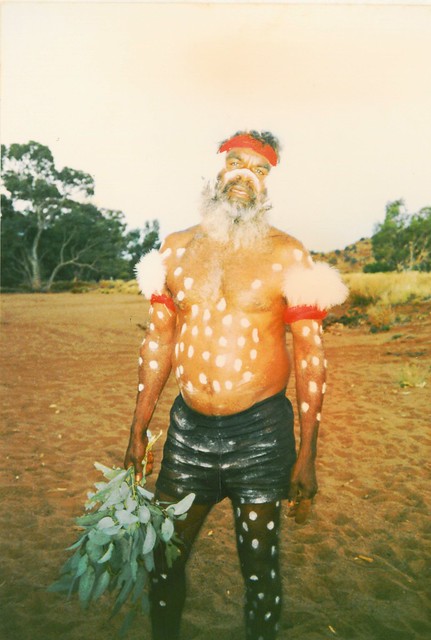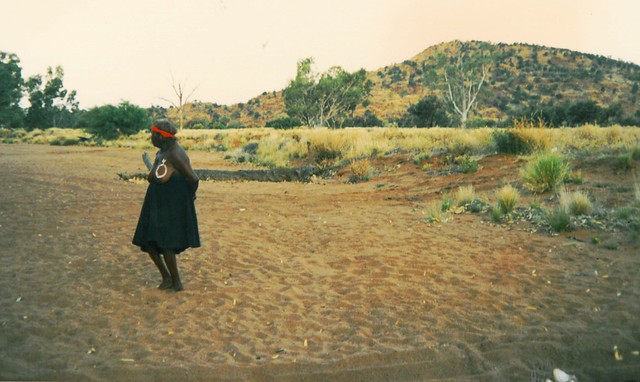Every night we all gathered around a big central campfire where we danced and sung together. After a while we were quite good performers in the Ngintaka Dreaming, although we did have some problems with the Pitjantjatjara text. But armed with music sticks and cups we got the hang of the beat.

At one of these inmas, Ilyatjari asked me (read: told me) to perform the Eagle Hawke Dance (Walawaru). After the act he gave me the totem name Walawaru, and thus I became part of the Angatja kinship.
The most important inma, however, took place on our day of departure. It started early in the morning. Men and women were separated and moved to different areas outside the campsite. The women were asked to take off their tops and were painted as the Ngintaka Man.
The only time that the women are bear breasted is at the inmas and initiation cermonies. All Anangu changed from completely naked to completely dressed virtually overnight.
The men were painted as emus. The painting was done with red ochre and white ash. Emu feathers were put behind the pulturro. It took the larger part of the morning to get ready. Finally, we performed the Emu Dreaming for the women while the women performed the Ngintaka Dreaming.
Andy, being the best dancer of the Anangu, highlighted this day with a very expressive dance. He performed as a lonely young man travelling through the country without family. He cried and because of the comics performed by Andy, everybody starts laughing. He then shouted at us: “You can laugh because you do have family, but I cry because I do not have family!” In a very relaxed way Andy showed us the importance of family life to the Anangu.

At the rock formation on the border of the land of the Anangu we stopped again, this time to say goodbye. Whilst sitting on the same rock, overlooking the land I saw a quite different land from when we arrived. It was not dry with just the same mountains. I now recognised trees and plants and knew that they bear fruits and that mountains are created by the Ngintaka Man, whose spirit I could clearly see around and could feel.
Earth and fire will never be the same again. The Tjukurrpa no longer is a story of nice fairy tales but a reality.
Glossary of Pitjantjatjara words
Traveling in the dreamtime Paul’s stay with Pitjantjatjara people in 1989 (TOC)
On separate occasions I have also written about the Darkinjung people who lived between Sydney and the Hunter Valley. I wrote that as part of the history of Bucketty where we lived from 1986 till 2019. We moved from here to Brisbane and in the early history I researched of this this city I also wrote about the Turrbal People.
